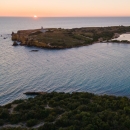Coastal Program/Programa Costero
The Coastal Program was established in the Caribbean in 2005. It focuses on helping communities, agencies and organizations face the challenge of integrating economic development with the conservation of our coastal resources, combining efforts for their protection and restoration.
What is the Coastal Program?
It is a voluntary participation program that provides technical and financial assistance (incentives) to individuals, public and private entities interested in conserving or restoring native vegetation, hydrology and soils in coastal ecosystems important to species protected by the U. S. Fish and Wildlife Service (Service). They include:
- Diadromous fish (fish that move between the sea and rivers)
- Migratory birds
- Species listed as threatened or endangered
- Priority species
- Candidate species for listing
- Native or endemic species with declining populations
Who can participate in the Coastal Program?
Any person, private or public entity interested in establishing cooperative agreements with the Service to implement conservation projects or practices that benefit coastal habitats can participate All participants must be willing to maintain the conservation practices and restored areas under this program for a minimum of 10 years. The Coastal Program also offers talks and workshops aimed to students and teachers; and collaborates in environmental educational projects such as the well-known Schoolyard Habitat Program.
What benefits does the Coastal Program offer?
By participating in this program, you collaborate directly with the conservation of the coastal resources of U.S. Caribbean Islands (i.e., Puerto Rico and U.S. Virgin Islands). In addition, the Service offers technical and economic assistance (incentives). Technical assistance is provided for the development of projects, including the design and establishment of conservation practices. Economic assistance is possible through cost-sharing or by fund pairing (1:1). Generally, the cost includes labor and materials, which is shared 50-50% between the owner or manager of the property and the Service. However, this percentage is flexible.
The collaboration of the participants can be an in-kind contribution such as labor and materials. Participant’s cost limit per is $50,000. Most projects do not exceed $25,000, and the established practices should be kept for a period of 10 years.
What type of conservation projects or activities does the Coastal Program promote?
By participating in the Coastal Program, the owner or manager of the property establishes a cooperative agreement with the Service that details conservation practices to restore or improve coastal habitat(s). Common practices include:
- Opening of closed channels to re-establish the original course of water)in coastal lagoons
- Establishment of buffer strips in bodies of water
- Creation of habitats for the benefit of birds and other species in places where they did not exist
- Improvement of threatened or endangered species habitat
- Maintaining natural areas that provide food and shelter to wildlife
- Restoration of wetlands and other coastal habitats
- Planting native trees in wetlands and other coastal ecosystems areas
- Restoration and conservation of cays ecosystems, mangrove forests, coastal forests and aquatic resources



